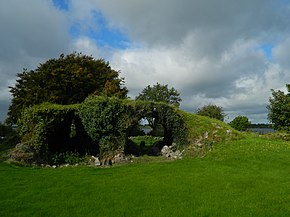Saints Island
| Saints Island | ||
 Saints Island |
||
| Geographical location | ||
|
|
||
| Coordinates | 53 ° 33 '17 " N , 7 ° 53' 36" W | |
| Waters 1 | Lough Ree | |
| length | 2 km | |
| width | 700 m | |
Saints Island ( Irish Oileán na Naomh ) is an inland peninsula southeast of Newtowncashel and west of Ballymahon in the eastern arm of Lough Ree in the extreme south of County Longford in Ireland . The former island is connected to the mainland by a narrow dam about one kilometer long.
The first monastery on the island was built in the 6th century by Ciarán of Clonmacnoise , who later founded the monastery in Clonmacnoise . In 1089 the island was sacked by King Murkertach O'Brien, mentioned in the Ulster annals, and the Vikings .
The resulting ruins as Augustinian -Priorat was before 1244 by Sir Henry Dillon of Drumrany ( English Sir Henry the Elder ) at the site of the former abbey built. The priory stands in the northwest of an oval cemetery. The ruins of a church from the 13th century, which was rebuilt in the 15th century, a heavily damaged cloister and the remains of some buildings are preserved. In the east gable of the church there is a three-part window from the 15th century, in the south wall a double piscina and an armarium . A square tower is built into the western end of the enclosure wall. To the northwest of the church there are two barrel vaults that were part of an originally two-story building with three chambers.
The monastery flourished during the 14th century under the scientific abbot Augustin Magraidin. He was the author of an important collection of manuscripts on the life of the Irish saint, Vitae Sanctorum Hiberniae, which was a valuable source for later writers. Magaidrin also compiled the annals of the abbey, in the Annals of the Four Masters ( Irish Annala Ríoghdhachta Éireann ; English Annals of the Four Masters was listed as source). Magaidrin died in 1405 AD. The monastery survived until the time of the suppression of the monasteries under Henry VIII and Elizabeth I. The devastated place lay fallow for centuries.
The place is a refuge for marsh birds. In spring curlews , lapwing and various ducks can be seen in large numbers.
See also
literature
- Peter Harbison : Guide to the National Monuments of Ireland , Dublin 1970, p. 43 f. ISBN 0-7171-0758-2 .
Web links
- Saints Island (English)
- Saints Island Priory (English)

